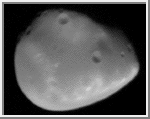













|
Deimos [DEE-mos] (panic) is a moon of Mars and was named after an attendant of the Roman war god Mars. Deimos is a dark body that appears to be composed of C-type surface materials. It is similar to the C-type (blackish carbonaceous chondrite) asteroids that exist in the outer asteroid belt. Some scientists speculate that Deimos and Phobos (the other martian moon), are captured asteroids; however, other scientists present arguments counter to this theory. Both Deimos and Phobos are saturated with craters. Deimos has a smoother appearance caused by partial filling of some of its craters.
| Animations of Deimos |
|---|
| Views of Deimos |
|---|
 Mosaic of Deimos
Mosaic of Deimos
Measuring 16 by 12 km (10 by 7.5 mi)
Deimos circles Mars every 30 hours. Craters of varying age dot its
surface, which is somewhat smoother than the surface of Phobos.
(Courtesy NASA)
 Six Views of Deimos
This picture shows six different orientations of Deimos. The images were rendered
by using Peter C. Thomas' model and a combination of the USGS airbrush map and a
photomosaic of Deimos.
Six Views of Deimos
This picture shows six different orientations of Deimos. The images were rendered
by using Peter C. Thomas' model and a combination of the USGS airbrush map and a
photomosaic of Deimos.
 Deimos
Deimos
This image was taken by the
Viking Orbiter spacecraft in 1977.
(Courtesy NSSDC/NASA)
 Deimos
Deimos
This image shows a slightly different view of Deimos. It was acquired
by the Viking Orbiter spacecraft.
(Courtesy Calvin J. Hamilton)
 Topographic Map of Deimos
Topographic Map of Deimos
This is a topographic map of Deimos. It is based upon the shape model of Phil
Stooke. As with all maps, it is the cartographer's interpretation;
not all features are necessarily certain given the limited data
available. This interpretation stretches the data as far as possible.
(Courtesy A. Tayfun Oner)
 Map of Deimos
Map of Deimos
This image is a photomosaic of Deimos, the outer satellite of Mars.
The leading side faces forwards in the orbit of Deimos. The trailing
side faces backwards along the orbit. Longitude
0 is at the blunter end with the most prominent craters, and faces Mars.
As with all conformal (true shape) projections, the scale in these maps
varies, increasing from the centre to the outer edge.
(Courtesy Phil Stooke, NSSDC, and NASA)
Copyright © 1997-2000 by Calvin J. Hamilton. All rights reserved. Privacy Statement.